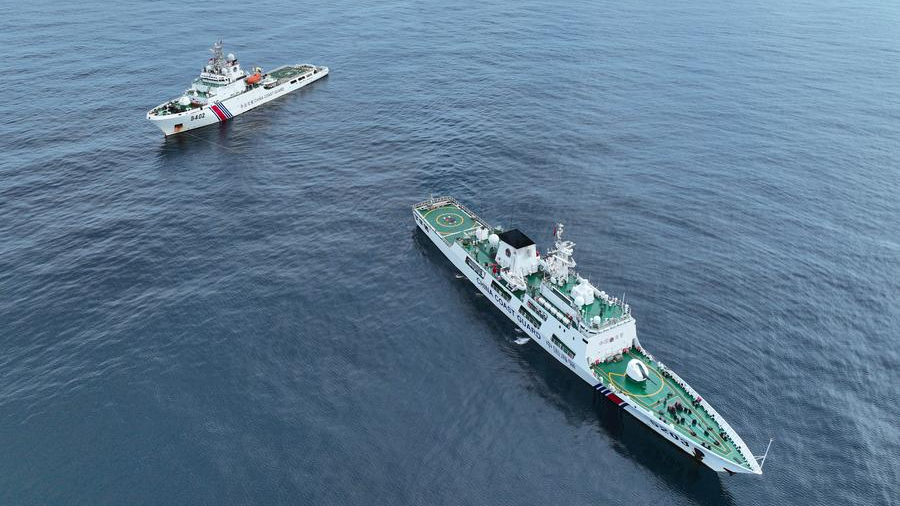
China Coast Guard (CCG) vessel Huayang (R) conducting a drill with another CCG vessel in the South China Sea, May 21, 2024. [Photo/Xinhua]
By Sun Wenzhu
Recently, the U.S. has once again been manipulating narratives on the South China Sea, aiming to intensify the already tense situation. On October 11, U.S. Secretary of State Antony Blinken substituting for U.S. President Joe Biden at the U.S.-ASEAN Summit, maligned China's activities in the South China Sea as "increasingly dangerous and unlawful" while claiming that the U.S. will "continue to support freedom of navigation and freedom of overflight in the Indo-Pacific."
Such accusations, together with all the sensationalism of Western media, reveal that the U.S. is again fabricating misleading rhetoric to incite confrontation among regional countries. These acts serve as excuses to expand its military presence in the region under the disguise of "freedom of navigation operations" and to meddle politically in the South China Sea issue.
As one of the world's most important and busiest international shipping routes and air corridors, the openness and freedom to pass through the South China Sea are indisputable. Every year, nearly 500,000 merchant vessels transit through the South China Sea and its surrounding straits, carrying 40 percent of global trade goods, while millions of civilian aircraft fly over the region.
This peace and stability have been safeguarded through the joint efforts of China and other countries in the South China Sea for decades. In fact, China and other parties to the South China Sea have consistently demonstrated the capability and wisdom to address differences through dialogue and consultation and work together to maintain order in the region.
However, the U.S. and some of its allies continue to accuse China of "impeding freedom of navigation" and "endangering navigation safety" in the South China Sea, deliberately misrepresenting China's maritime rights enforcement activities as responses to provocations concerning its territorial sovereignty.
For example, the Philippines has repeatedly attempted to send vessels carrying construction materials to the illegally grounded BRP Sierra Madre (LT-57), which has been used as a military outpost at Ren'ai Jiao since 1999. In addition, it has used government vessels to intrude into waters near Huangyan Dao and attempted to challenge China's sovereignty over Xianbin Jiao. In response to these provocations, China's Coast Guard has employed navigation controls and other measures to safeguard its territorial sovereignty over the related features.
These frictions are frequently instigated by other parties, often with U.S. support. Such provocations should not be categorized as normal navigational activities, nor is it fair to label China's responses as "impeding freedom of navigation."
Yet in many cases, the intruders often portray themselves as victims. According to rough estimates in 2023, the Philippines initiated 14 supply missions to the illegally grounded warship Sierra Madre and invited journalists to board supply ships. They used selective editing to highlight the size disparity between Chinese and Filipino vessels, framing China as "coercive and bullying," while omitting the fact that these Filipino activities were violations of China's sovereignty in the first place.
Meanwhile, the U.S. has significantly increased its military activities in the South China Sea over the past several years. According to the recent Report on the Navigation and Overflight Situation in the South China Sea issued by the South China Sea Strategic Situation Probing Initiative, the U.S. Navy now maintains approximately 1,600 ship-days of surface vessel presence annually, along with over 3,000 ship-days of auxiliary vessel activities, in addition to an undisclosed number of submarines (combat vessels) in the area. Moreover, earlier this year, the U.S. attempted to deploy an intermediate-range missile system in the Philippines.
The frequent activities of the U.S. military create risks and tensions with the Chinese military in the South China Sea. U.S. vessels and aircraft conduct close-in reconnaissance near China's territorial waters, trespass into its administered maritime zones and airspace, harass routine Chinese military exercises, and engage in irresponsible and dangerous maneuvers.
These actions compel the Chinese military to respond with warnings, expulsions, or more assertive measures, such as interceptions and pushbacks. The U.S.'s disruptive behaviors in the South China Sea pose a serious threat to China's national security and the safety of its people.
In fact, the alleged "freedom of navigation" promoted by the U.S. is merely a pretext to safeguard its military and diplomatic interests and maintain maritime hegemony at the expense of regional peace and stability. The South China Sea is a shared home for regional countries and should not be turned into a hunting ground for the U.S. to pursue its geopolitical ambitions. Regional nations must firmly oppose the U.S.'s actions in the South China Sea.
Sun Wenzhu, a special commentator on current affairs for CGTN, is an associate research fellow at the China Institute of International Studies.

 中文
中文



